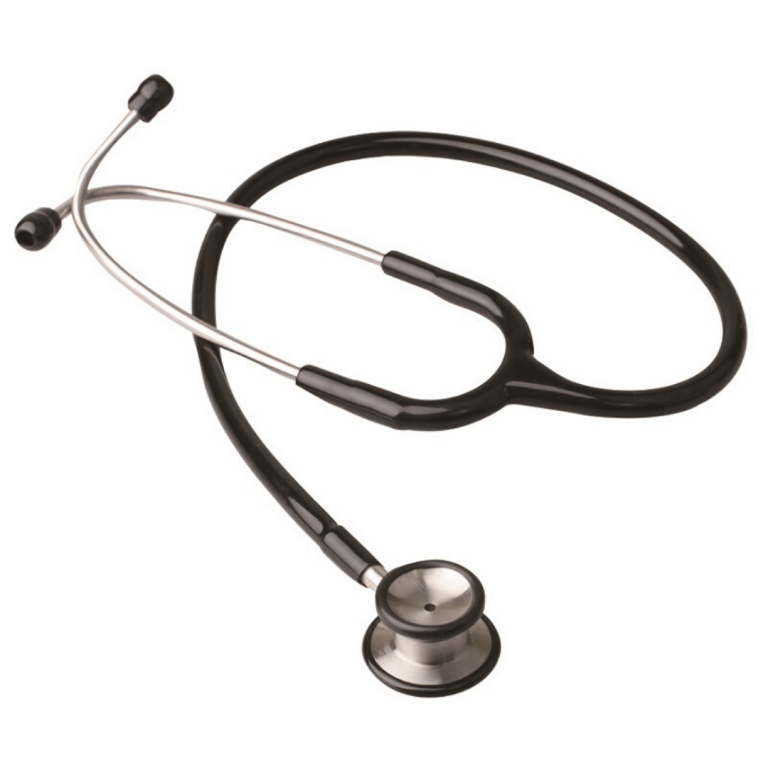Stethoscope Littman Principle
It is crucial to comprehend how a stethoscope's anatomy enables it to execute the function of auscultation before delving into the general anatomy of a stethoscope. It essentially boils down to sound waves and vibrations, two significant phenomena. The patient's respiration and heartbeat generate sound waves that force the stethoscope's diaphragm, also referred to as the chest piece, to vibrate against the patient's chest. Then, through the hollow tubing of the mechanism, these vibrations ascend to the earpieces.
Product Features
- Next-generation tubing
- Tunable diaphragm
- Dual-lumen tubing
- Headset
- Aerospace aluminum alloy ear tube
- Snap-tight and soft sealing ear tips
What to examine as a doctor?
- Sharp and loud sounds can be heard across the trachea.
- Bronchial: Loud and hollow sound heard in the front of the chest.
- Vesicular: Soft, low, and rustling sound heard in most lung fields.
Functions of the Littman Stethoscope
- Fluid in the lungs: To identify if fluid obstructs your ability to breathe, which can be brought on by pneumonia, heart failure, and pleural effusion, doctors listen for absent or diminished breath sounds.
- A noise resembling snoring: When airflow via your major airways is restricted or impeded, this sound is produced. Rhonchi may reveal the patient's presence of cystic fibrosis, chronic bronchitis, asthma, or pneumonia.
- A narrow valve: Every valve makes a particular murmur sound. The murmur will allow doctors to pinpoint which valve is malfunctioning. The severity of the issue will then be determined.
- Leaky valves make a "whooshing" sound instead of the "thud, thud" of a normal heartbeat, which doctors can hear. Doctors can determine which valve is leaking and how much blood is exiting by different "whooshes" between "thuds."
- "Abnormal cardiac rhythm" or arrhythmias: Your heart's irregular rhythm can be detected by the abnormal heartbeat that doctors are listening for.
Why the Stethoscope Littman?
It helps doctors to identify crucial chest sounds easy, such as:
- Rales: Sounds made when inhaling, such as clicking, bubbling, or rattling.
- Ronchi: Snoring-like gurgling noises.
- Stridor: A loud, high-pitched sound that is almost creaking.
- Wheeze: A high-pitched whistling sound, especially on exhalation.

Stethoscope Parts
- Chest piece - It is obvious from the name that this is the portion of the stethoscope pressed on the patient's chest. The diaphragm, the bell, and the stem make up this object. The diaphragm can be one-sided and tunable, two-sided, or two-sided and tunable. By changing the pressure, tunable diaphragms enable the capturing of various frequencies. You can hear low-frequency sounds while the pressure is low and higher-frequency ones when the pressure is increased.
The bell, the more compact, circular end, can also hear low-frequency noises. Smaller patients, in general, or pediatric patients, in particular, benefit greatly from it. The stem provides an acoustic channel to the ear tips for maximum functionality, which joins the chest piece to the tubing.
- Headset - This portion of the stethoscope comprises several parts, principally the aural tubes and earpieces, similar to the chest piece. The acoustic tube and the earpieces are joined with auditory tubes, also known as ear tubes, which are hollow metal tubes. They are often composed of steel or an aluminum alloy for optimal strength and longevity while maintaining light weight.
These tubes enter the ear tips, commonly constructed of silicone or rubber. The doctor can hear everything they require to diagnose by gently placing them in the ear canal. They form a seal inside the ear, delivering crucial noise cancellation for the best possible sound transmission.
- Tubing - The tubing is hollow, soft, and flexible, carrying the noises detected by the chest piece to the doctor's ears. Most contemporary stethoscopes use double-lumen tubing, producing two sound pathways, such as the 3M Littmann. The most common material used to make tubing is polyvinyl chloride (PVC), which has a very long lifespan and is somewhat resistant to weathering from being worn around the neck and from heavy use.
Summary
When using the Littmann stethoscope, the doctor can hear, feel and see the difference between the results of this product and those of other models. An internal 3M test revealed that heart sounds detected with a Littmann stethoscope's adult diaphragm were more than four times louder (20 dB) than those detected using a stethoscope from a different manufacturer.
That's comparable to the distinction between talking and whispering. It can mean the crucial difference between a patient hearing anything important or not hearing anything at all. Because they are smooth, they fit into your ears without irritating you. Now attempt to remove one from the ear tube. The ear tips click shut for the best possible acoustic performance and security. Feel the weight at last. Stethoscopes made by Littmann are lightweight and convenient to wear around your neck or carry in your pocket.

